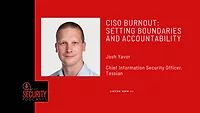Bolstering mental health to defend against burnout among security professionals

With 70% of people increasingly concerned with their safety and health due to the pandemic and 94% of workers reporting concerns about going back to their workplace, it’s clear that workers aren’t in a hurry to return to the office. Companies like Airbnb, Salesforce, Facebook, Uber, and Google have listened by extending remote work for at least another year, and some companies like Okta, Zillow, and Twitter are favoring indefinite work-from-home arrangements.
However, despite widespread confidence in remote work and its resulting benefits (e.g. no commuting, more time with friends/family, decreased costs), workers are still feeling the immense pressure that comes from an always-on mentality. The result: blurred work/home lines that create longer workdays and increased employee burn out. Security teams are especially feeling the heat; a study from CIISec found that more than half of security professionals have left a security job due to burnout or worked with someone who did.
Security teams are especially feeling the heat; a study from CIISec found that more than half of security professionals have left a security job due to burnout or worked with someone who did.
Companies need to tangibly improve employee well-being, particularly when it comes to their security professionals.
Here are three measures the security leaders can incorporate into their organization now, before employees hit a breaking point:
Get in front of burnout: Push for mandated time off for all employees
The pandemic has sparked an unprecedented wave of security threats. Effective security teams are needed more than ever, but security professionals are also facing more pressure than ever. This pressure won’t dissipate anytime soon, especially as many threats move away from the relative security of a controlled office environment. Fighting more threats means working more hours with more stress.
Security professionals need a break. But they probably won’t take one on their own. Vacation requests have dropped by almost half compared to this time last year. For teams to operate to the best of their abilities, they’ll need to rest and destress through employer-mandated time off.
Track motivation as a mental health metric, and tailor it accordingly
Burnout and a lack of motivation often walk hand-in-hand. Both result in productivity declines or slip-ups, something that security teams simply cannot afford. The secret to keeping teams properly motivated, even amidst external chaos, is by implementing a tailored and personalized approach.
Too many chief security officers (CSOs) implement a one-size-fits-all motivation method, which inevitably results in a loss of purpose. While one employee may be motivated by a promotion, another employee may be motivated by meaningful work. Through intentional interactions, leaders can come to understand what motivates each of their distinctive employees.
It’s important for leaders to take a proactive stance on employee’s well-being because employees are unlikely to discuss their motivational needs directly and may not even consider them on their own. By implementing regular surveys and check-ins, leaders can spark self-reflection and keep a pulse on their employees’ mental fitness. From there, leaders can implement personal plans that keep their employees at peak performance.
Push for greater budget and enhanced flexibility
Additional security budgets are more needed than ever, yet 81% of leaders are feeling pressure to lower security costs. Despite this pressure, 42% of global businesses have hired additional security professionals during the pandemic.
The truth is that security teams are understaffed and under-resourced, an equation that could all too easily lead to an unbalanced load of work and stress. Listen to your teams, regularly ask them about their workloads, and if needed, make additional hires or invest in new collaboration tools. During times like these, sometimes you need to prioritize the health of your employees versus the health of your balance sheet.
If additional budget isn’t at your disposal, lighten your employee’s load as much as possible by offering flexible work schedules. Other than the all-hands-on-deck incidents that require action at a specific moment in time, let employees decide when and where to work. This will help them design a workday that works best for them, and will give them the space to handle other priorities outside of work that would otherwise be another source of stress. The result will be healthier and happier employees.
Looking for a reprint of this article?
From high-res PDFs to custom plaques, order your copy today!








